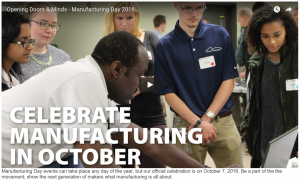Why Manufacturing Education Needs to Advance, Just Like You Have
Stuck in the Industrial Age, skills training doesn’t place enough emphasis on smart, connected product manufacturing, advanced material development and digital design integration.
(IW – Randy Swearer: 8-23-16) If you’ve read the Manufacturing Institute report, you’ve heard the statistics: 84% of manufacturing executives believe there is a talent shortage in the U.S. and worry that they won’t find the workforce they need to keep up with the increasingly more advanced and sophisticated demands of the industry.
And talent is the number one driver of global manufacturing competitiveness.
So why can’t manufacturers find and attract skilled talent?
One reason is that our manufacturing education system is stuck in the old Industrial Age of metalworking and welding. It doesn’t place enough emphasis on smart, connected product manufacturing, advanced material development and digital design integration.
Due to this gap, students—your next potential employees—may not be aware of exciting developments like 3-D prototyping and printing taking place within the industry or the multitude of careers available to them.
With the world economy placing a higher value on advanced manufacturing, we need to place a higher value on advancing manufacturing education.
Here are some ways we can build a more advanced and dynamic workforce:
Create Hands-on Opportunities Within Education Systems
As with most disciplines at the university level, manufacturing curricula in fields like engineering, software development and IT are still taught from a textbook. The setting and structure take away the hands-on, real-world learning that students could be experiencing. They miss out on the exciting part, and don’t really understand what manufacturing is like on a day-to-day basis.
Businesses and educational institutions need to work together to develop new curricula that provide hands-on, learning-through-making opportunities.
We are beginning to see the success of these collaborative learning environments at several universities, such as Rochester Institute of Technology’s Studio 9.30, a multidisciplinary studio focused on the development of health-technology products that benefit community partners. Penn State Behrend’s new Advancing Manufacturing and Innovation Center provides a space for academic and industry partners to collaborate on research and manufacturing projects.
Not only will these students have real-world experience, but they will also understand the vast changes and advancements that are taking place within our industry.
Focus on Real-world Application of Skills
As long as traditional grades continue to be the marker for success at higher institutes of learning, students won’t gain the critical hands-on education to prepare them for their future careers.
According to the 2014 U.S. Department of Labor report, 65% of careers that students will be taking on in the future don’t exist today. Therefore, the chasm between what students learn in their current classroom environment and the expectation for skills in the real world is wide and difficult to breach.
This gap will only close if universities take a bold approach and redefine what success means and how students get there. For example, an influx of teachers is utilizing online platforms to help students publish work done outside of the classroom, so it can be accounted for as part of the curriculum. Through learning platforms, employers are able to look for and assess design and engineering candidates beyond a letter grade by viewing an individual’s e-portfolio.
Georgia Institute of Technology student Israel Del Toro’s e-portfolio consists of hypothetical as well as real-world design projects he completed in and outside the classroom, such as a new hand-held power tool, an electric razor and an innovative light fixture.
If you haven’t done so already, encourage your hiring managers to place value on applicants who have pursued external opportunities outside the classroom, and have something to show for it.
Develop and Elevate Micro-credentialing Programs for Students and Employees
With school curricula slow to change, students are increasingly going across disciplines and outside of the classroom to learn new things and pursue their interests.
With the proliferation of organizations like General Assembly, Codecademy and even public makerspaces like TechShop, students not only want to learn new skills; they also want to be recognized for their accomplishments outside of school. With micro-credentialing and digital badges, they can highlight their new competencies to potential employers.
More than a hundred educational institutions, private companies and employment groups have banded together in a recent initiative called Connecting Credentials to make it easier for candidates and employers to build the skill sets they need. In addition, Certiport works with software companies to develop and administer certifications in specialized industry competencies, such as 3D design skills through AutoCAD and Autodesk Fusion 360 certifications.
Both the talent gap and education divide are not going to be solved overnight. However, a good starting point is a collective conversation around advancing the education system to better fit this ever-changing industry. Ultimately, working together will lead us to a better-equipped advanced manufacturing workforce.
(Randy Swearer is the vice president of global education experiences for the design and engineering software company Autodesk.)
